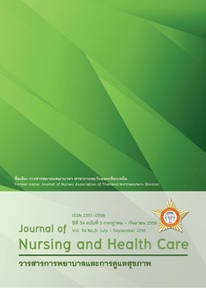ประสิทธิผลของโปรแกรมการดูแลแบบผสมผสานสำหรับผู้ป่วยโรคเบาหวานชนิดที่ 2 ที่มีความเสี่ยงต่อการเกิดแผลที่เท้า Effects of a Comprehensive Care Program for Type II Diabetes Patients with A Risk of a Foot Ulcer
คำสำคัญ:
โปรแกรมการดูแลแบบผสมผสาน ผู้ป่วยโรคเบาหวานชนิดที่ 2 ความเสี่ยงต่อการเกิดแผลที่เท้า comprehensive care program, type II diabetes patient, risk to foot ulcerบทคัดย่อ
บทคัดย่อ
การวิจัยกึ่งทดลองนี้ มีวัตถุประสงค์เพื่อศึกษา 1) ผลของโปรแกรมการดูแลแบบผสมผสานต่อความรู้เกี่ยวกับโรค
เบาหวานของผู้ป่วยโรคเบาหวานชนิดที่ 2 ที่มีความเสี่ยงต่อการเกิดแผลที่เท้าและผู้ดูแล 2) ผลของโปรแกรมการดูแลแบบผสมผสานต่อพฤติกรรมการดูแลสุขภาพของผู้ป่วยโรคเบาหวานชนิดที่ 2 ที่มีความเสี่ยงต่อการเกิดแผลที่เท้าตามที่ปฏิบัติจริงและตามที่ผู้ดูแลสังเกต และ 3) ผลของโปรแกรมการดูแลแบบผสมผสานต่อสุขภาพร่างกาย จิตใจ สังคม และการรับรู้ความรู้สึกที่เท้าของผู้ป่วยโรคเบาหวานชนิดที่ 2 ที่มีความเสี่ยงต่อการเกิดแผลที่เท้า โดยใช้กรอบแนวคิดการดูแลแบบผสมผสาน กลุ่มตัวอย่างเป็นผู้ป่วยโรคเบาหวานชนิดที่ 2 ที่มีความเสี่ยงต่อการเกิดแผลที่เท้า และผู้ดูแล ในโรงพยาบาลส่งเสริมสุขภาพตำบล 2 แห่ง อำเภอเรณูนคร จังหวัดนครพนม ที่เลือกแบบสุ่มอย่างง่าย เป็นกลุ่มทดลอง จำนวน 30 คู่ ส่วนกลุ่มเปรียบเทียบเป็นผู้ป่วยที่มีลักษณะคล้ายคลึงกัน จำนวน 30 คู่ เครื่องมือในการวิจัย มี 2 ชุด ได้แก่ เครื่องมือที่ใช้ในการทดลอง ได้แก่ 1) โปรแกรมการดูแลแบบผสมผสาน ประกอบด้วย การบรรยาย การฝึกทักษะในฐานกิจกรรม และการเยี่ยมบ้าน ระยะเวลาการดำเนินการ 6 สัปดาห์ 2) คู่มือการดูแลโรคเบาหวานแบบผสมผสาน และ 3) โปสเตอร์ในการดูแลสุขภาพเท้า เครื่องมือที่ใช้ในการเก็บรวบรวมข้อมูล ได้แก่ 1) แบบสัมภาษณ์ผู้ป่วยโรคเบาหวาน และ 2) แบบสัมภาษณ์ผู้ดูแลผู้ป่วยโรคเบาหวาน สถิติที่ใช้ในการวิเคราะห์ข้อมูล ได้แก่ สถิติพรรณนาและสถิติทดสอบทีผลการวิจัย พบว่า 1) ความรู้เกี่ยวกับโรคเบาหวานของผู้ป่วยโรคเบาหวานชนิดที่ 2 ที่มีความเสี่ยงต่อการเกิดแผลที่เทา้ และผูดู้แล หลังเขา้ รว่มโปรแกรมดีกวา่ กอ่ นเขา้ รว่ มโปรแกรมและดีกวา่ กลุม่ เปรียบเทียบอยา่ งมีนัยสำคัญทางสถิติที่ระดับ.05 2) พฤติกรรมการดูแลสุขภาพของผู้ป่วยโรคเบาหวานชนิดที่ 2 ตามที่ผู้ป่วยปฏิบัติจริงและตามที่ผู้ดูแลสังเกต หลังเข้ารว่ มโปรแกรมดีกวา่ กอ่ นเขา้ รว่ มโปรแกรมและดีกวา่ กลุม่ เปรียบเทียบอยา่ งมีนัยสำคัญทางสถิติที่ระดับ .05 3) สุขภาพรา่งกายจิตใจ สังคมและการรับรู้ความรู้สึกที่เท้าของผู้ป่วยโรคเบาหวานชนิดที่ 2 หลังเข้าร่วมโปรแกรมดีกว่าก่อนเข้าร่วมโปรแกรมและดีกว่ากลุ่มเปรียบเทียบอย่างมีนัยสำคัญทางสถิติที่ระดับ 0.05 โปรแกรมการดูแลแบบผสมผสานในครั้งนี้สามารถนำไปปรับใช้ได้และควรมีการศึกษาดูความยั่งยืนของผลการใช้โปรแกรมดังกล่าวต่อไป
Abstract
This quasi-experimental research aimed to study: 1) the effects of a comprehensive care program on diabetes knowledge of type II diabetes patients with a risk of a foot ulcer and their caregivers, 2) the effects of the comprehensive care program on health care behaviors of type II diabetes patients with a risk of the foot ulcer as actual practice and being observed by their caregivers, and 3) the effects of the comprehensive care program
on physical, mental, and social health and foot sensation of type II diabetes patients with a risk to the foot ulcer in the concept of comprehensive care. Subjects, selected by the simple random sampling technique, were type II diabetes patients with the risk of the foot ulcer and their caregivers in 2 Primary hospital sub district, Renu Nakhon district, Nakhon Phanom province. They were divided into two groups, experimental and control, each with 30 pairs of DM patients andtheir caregivers. Two sets of research instruments were used. Experimental tools consisted of 1) the 6-week comprehensive care program –lectures, skill practice at activity bases, and home visits, 2) guidelines for diabetes comprehensive care, and 3) foot care posters. Other data collection tools were 1) interview questionnaires for type II diabetes patients, and 2) interview questionnaires for caregivers. Data was analyzed by descriptive statistics and t-test. Research findings revealed as follows. 1) Scores of diabetes knowledge of type II diabetes patients with the risk of the foot ulcer and their caregivers was better than before enrolling in the program and the control group (p < 0.05). 2) Health care behaviors of type II diabetes patients with the risk of the foot ulcer as actual practice
and being observed by their caregivers was better than before enrolling in the program and the control group
(p < 0.05). 3) Physical, mental and social health and foot sensation of type II diabetes patients with the risk of
the foot ulcer was better than before enrolling in the program and the control group (p < 0.05). It is recommended
that this comprehensive care program can be applied in other settings and should be assessed for its continuous
effectiveness and sustainability.



